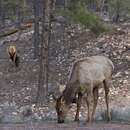The General Ecology of Cervus canadensis
provided by EOL authors
The Rocky Mountain Elk inhabits a variety of habitats ranging from open prairies and mountain ranges in western North America to the low-lying temperate forests of the east. In the United States alone C. canadensis can be found in all of the western states as well as the eastern states of Wisconsin, Michigan, Minnesota, Missouri, Pennsylvania, Arkansas, Kentucky, Tennessee, Virginia, and North Carolina (1). The preferred range of the animal is areas with abundant tree cover and food sources along with minimal pressure from predators. Their senses of vision and hearing are also both very strong and play a major role in keeping these animals alive as well (1). Rocky Mountain Elk are very vocal animals, using calls to communicate with other members of their group. These calls alert the animals to any danger that may be present, let the animals know where other members of the group are, and are used very prominently during the rut (mating season). The elk also have very keen sense of smell, which they use to detect danger, this is especially important for detecting humans (2). Especially in a predator-rich environments, elk select areas of heavy cover (such as trees or brush) for bedding. The more pressure these animals have from predators, the thicker the timber they will bed in. The thicker brush or timber surrounding a bedding area makes it very difficult for any predators to silently approach the sleeping, but still very much aware elk (2,3). During the summer and winter seasons elk use different areas for different purposes. During the summer months elk in mountainous areas tend to live at higher elevations in deep timber near open meadows for feeding. In the winter they move to lower elevations with open, windblown slopes that will expose feeding areas from the heavy winter snow (3). The elk in regions with less snow (such as populations in the eastern United States and the animals living in the western prairies) live in the same areas all year long. Many social interactions occur within populations of the Rocky Mountain elk as with the surrounding species. Elk are very vocal, with different calls having a vast array of meanings. Females (cows) are the most talkative throughout the year especially in the months following calving season. They talk to the rest of the heard and their calves through a series of chirps, barks, and mews. This helps them keep track of one another and communicate with the heard (1). The bark, is used by both bulls and cows, is an alert for danger which warns all animals to clear the area (1,2). Any surrounding species such as mule deer and squirrels prepare for danger when this call is made. Bull elk will usually join in on general conversation in times other than the rut. During the rut, which takes place in the fall, a bull will use a series of bugles and grunts as well as body language to keep his harem of cows near him and express dominance (1,2). During fights for dominance bulls use their massive antlers to determine which individual will get to mate the cows for that year. After the rut, cows will group with smaller bulls and other cows to over-winter. The larger bulls separate in to small bachelor groups that hang close to cows to protect them from danger during winter (3).

